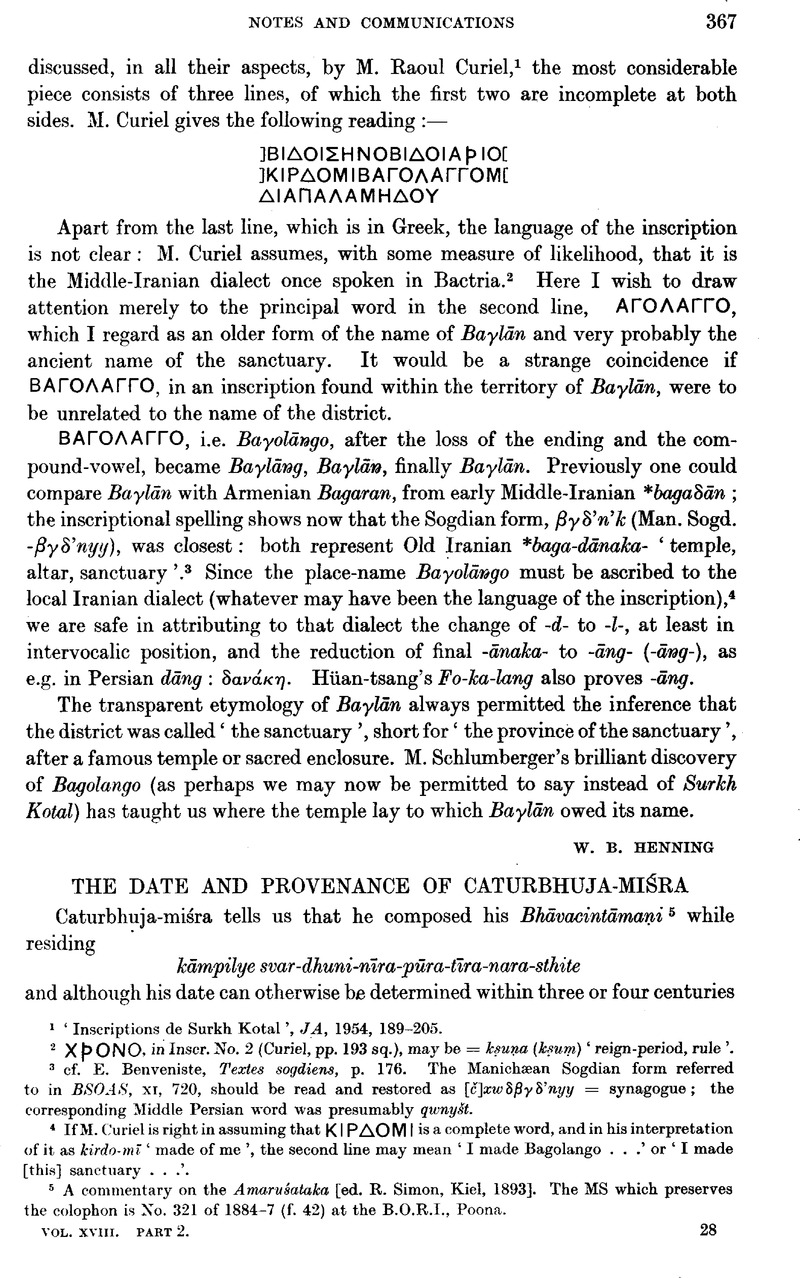No CrossRef data available.
Published online by Cambridge University Press: 24 December 2009

page 367 note 1 ‘Inscriptions de Surkh Kotal’, JA, 1954, 189–205.
page 367 note 2 XONO, in Inscr. No. 2 (Curiel, pp. 193 sq.), may be = kṡuṇa (kṡuṃ) ‘reign-period, rule’.
page 367 note 3 cf. E. Benveniste, Textes sogdiens, p. 176. The Manichṡan Sogdian form referred to in BSOAS, XI, 720, should be read and restored as [č]xwδβγδ'nyy = synagogue; the corresponding Middle Persian word was presumably qwnyŠt.
page 367 note 4 If M. Curiel is right in assuming that KIPΔOMI is a complete word, and in his interpretation of it as kirdo-mī ‘made of me’, the second line may mean ‘I made Bagolango…’ or ‘I made [this] sanctuary…’.
page 367 note 5 A commentary on the Amaruśtaka [ed. Simon, R., Kiel, 1893]Google Scholar. The MS which preserves the colophon is No. 321 of 1884–7 (f. 42) at the B.O.R.I., Poona.
page 368 note 1 Gode, P.K., Studies in Indian literary history, I, Bombay, 1953,Google Scholar contains a reprint of the original article, which is in the Adyar Library Bulletin, VII, 1943, 69–74.Google Scholar
page 368 note 2 Mysore Archaeological Survey, Epigraphia Carnatica, v, Belur 24 [A.D. 1298].
page 368 note 3 Mysore Archaeological Survey. Annual Report for 1911–12, § 93 [1303]; ibid., 1912–3, § 85 [1303].
page 369 note 1 ibid.
page 369 note 1 ‘Iṣāmī, , The Futuḥ-us-salātīn, edited by Husain, A. Mahdi, Agra, 1938, pp. 327–8.Google Scholar
page 369 note 2 Ep. Carn., VIII, Nagar 19 [1320].
page 369 note 3 The series is India. Archaeological Survey, South-Indian Inscriptions; texts, IX, 1, 356 [1324]; Ep. Carn., XII, Tiptur 24 [1325]; Ep. Carn., XI, Hiriyur 16 [1325]; Mys. Arch. Survey. Ann. Rep. for 1923, § 121 [c. 1325].
page 369 note 4 Ep. Carn., XI, Hiriyur 16 [1325].
page 369 note 5 ‘Iṡāmī, op. cit., pp. 410–7, where ‘Hndrg’ = Hosadrug. See , Ibn![]() , Voyages. Texte arabe, accompagné d'une tradiiction par C Defrémery et B.R. Sanguinetti, III, Paris, 1855, 318–22.Google Scholar
, Voyages. Texte arabe, accompagné d'une tradiiction par C Defrémery et B.R. Sanguinetti, III, Paris, 1855, 318–22.Google Scholar
page 370 note 1 India. Archaeological Survey. Annual Report on South Indian Epigraphy for 1935–6, app. E. 21 [? 1327].
page 370 note 2 Venkataramanayya, N., Kampili and Vijayanagara, Madras, 1929.Google Scholar
page 370 note 3 On ![]() Paranāriyarige Sahodaranembantha Kathe see Jois, H. Sreenivasa in Q.J. of the Mythic Society, XXXII, 1941–1942Google Scholar, 58 ff.; on
Paranāriyarige Sahodaranembantha Kathe see Jois, H. Sreenivasa in Q.J. of the Mythic Society, XXXII, 1941–1942Google Scholar, 58 ff.; on ![]() Kumāra Rāmana Sangatya see Sharma, M.H. Kama, The exploits of Kampila and Kumara Rāmanātha, supplement to QJMS, xx, 2, 1929; also Mys. Arch. Survey. Ann. Rep. for 1929, pp. 36–7; QJMS, xx, 1929–30, pp. 89–106, 201–11. See also Ancient India, No. 5, 1949, p. 57.Google Scholar
Kumāra Rāmana Sangatya see Sharma, M.H. Kama, The exploits of Kampila and Kumara Rāmanātha, supplement to QJMS, xx, 2, 1929; also Mys. Arch. Survey. Ann. Rep. for 1929, pp. 36–7; QJMS, xx, 1929–30, pp. 89–106, 201–11. See also Ancient India, No. 5, 1949, p. 57.Google Scholar
page 370 note 4 Rajamanikkam, M., Periya-purāṇa-ārāyccī, Madras, 1948, map on p. 200.Google Scholar
page 370 note 5 The Mahābhārata, [critical edition,] Poona, 1927–, Ādiparva I, 128, 15:
Mākandīm atha ![]() janapadāyutām
janapadāyutām
so'dhyāvasad dīnamanāḥ Kāmpilyaṃ ca purottamam.
For other references see Sorensen, S., An index to the names in the Mahābhārata, London, 1904, 379Google Scholar. Also Law, B.C., Historical Geography of ancient India, Paris, [1954], 91–3.Google Scholar
page 370 note 6 The commentaries on the Vana, Virāṭa, Droṇa, Karṇa, Bhīṡma, and Āraṇyaka parvas have been located.
page 370 note 7 See Gode, P.K., ‘New light on the chronology of the commentators of the Mahābhārata’, Annals of the B.O.R.I.,xxv, 1944, 103–8Google Scholar, at 106. Professor V. Raghavan, there cited, places Ānandapūrna about 1350 on account of his having claimed to write during the reign of one Kāma-dīva. This king is assumed to be a ruler of Goa identified with the king mentioned in an epigraph of 1393. This is not very attractive, but even if the Kāma-dīva were a Kadamba of ![]() or of Gōve the dating need not be advanced much before a lower limit of c. 1338.
or of Gōve the dating need not be advanced much before a lower limit of c. 1338.
page 371 note 1 As Dr. Gode points out, Studies, I 345, n. 1.
page 371 note 2 An excellent example is provided in South-Ind. Ins., XI, 1, 114 [A.D. 1054, which should be read in conjunction with the reference to Kampili in India. Archaeological Survey, Epigraphia Indica, XXI, p. 226], where we see a feudatory of the Cāḷukya named Vīra-Noḷamba Gaṭṭidēva making a gift ‘Kaṃpiliya nelevīḍina ![]() This is conclusive.
This is conclusive.